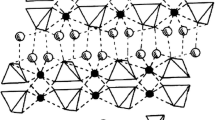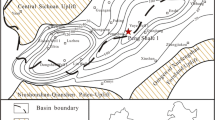Abstract
Failure analyses of the insoluble interlayers are critical for a salt cavern leaching for natural gas storage. In this study, a series of brine immersion tests was carried out to investigate the softening laws of the mechanical characteristics of an argillaceous anhydrite interlayer. The test results show that brine immersion decreases the mechanical strength of the interlayer. A softening depth model of the interlayer specimens was developed based on the experimental results. This model was used to establish a mathematical model of the softening of an overhanging interlayer in a salt cavern during leaching. The softening model can predict the softening scope and the residual strength of the interlayer in different softening zones at different leaching times. The model was integrated with a numerical simulation to analyze the characteristics of failure of an overhanging interlayer. It was found that the interlayer tends to fail when the brine immersion time reaches a certain value in the simulation. Finally, the influence of environmental and artificial factors on the softening laws of the insoluble interlayer was discussed. It was found that the matrix structure and soluble components of the interlayer are two significant environmental factors and the brine immersion time is the key artificial factor. Therefore, the failure of an interlayer can be controlled by adjusting the brine immersion time during leaching a salt cavern.












Similar content being viewed by others
References
Arthur JRF, Menzies BK (1972) Inherent anisotropy in a sand. Géotechnique 22(1):115–128
Bieniawski ZT (1978) Determining rock mass deformability: experience from case histories. Int J Rock Mech Min Sci 15:237–247
Carpinteri A, Chiaia B (1995) Multifractal nature of concrete fracture surfaces and size effects on nominal fracture energy. Mater Struct 28(8):435–443
Chen J, Ren S, Yang C, Jiang D, Li L (2013) Self-healing characteristics of damaged rock salt under different healing conditions. Materials 8(6):3438–3450
Chen J, Jiang D, Ren S, Yang C (2016) Comparison of the characteristics of rock salt exposed to loading and unloading of confining pressures. Acta Geotech 11(1):221–230
Consenza PH, Ghoreychi M, Bazargan-Sabet B, Marsily GD (1999) In-situ rock permeability for long term safety assessment of storage. Int J Rock Mech Min Sci 24:509–526
Firme PALP, Roehl D, Romanel C (2016) An assessment of the creep behaviour of Brazilian salt rocks using the multi-mechanism deformation model. Acta Geotech 11(6):1–19
Gao HB, Liang WG, Yang XQ, Zhang CD, Yue GY, Zhang P (2011) Experimental study of mechanical property of gypsum rock soaked in hot saturated brine. Chin J Rock Mech Eng 30(5):935–943 (in Chinese)
Heuze FE (1980) Scale effects in the determination of rock mass strength and deformability. Rock Mech 12:167–192
Houben ME, Hove AT, Peach CJ, Spiers CJ (2013) Crack healing in rock salt via diffusion in adsorbed aqueous films: microphysical modelling versus experiments. Phys Chem Earth 64:95–104
Itasca Consulting Group Inc (2005) Fast Lagrangian analysis of continua in 3 dimensions (FLAC3D Version 3.0). Itasca Consulting Group Inc., Minneapolis
Jong CD (2015) Gas storage valuation and optimization. J Nat Gas Sci Eng 24:365–378
Jiang D, Yi L, Chen J, Ren S (2016) Laboratory similarity test relevant to salt cavern construction in interlayer containing moulded saliferous aggregates specimen. Curr Sci 111(1):157–167
Lemaitre J (1984) How to use damage mechanics. Nucl Eng Des 80(2):233–245
Li YP, Liu W, Yang CH, Daemen JJK (2014) Experimental investigation of mechanical behavior of bedded rock salt containing inclined interlayer. Int J Rock Mech Min Sci 69(3):39–49
Liu W, Chen J, Jiang DY, Shi XL et al (2016) Tightness and suitability evaluation of abandoned salt caverns served as hydrocarbon energies storage under adverse geological conditions (AGC). Appl Energy 178:703–720
Liu W, Muhammad N, Chen J et al (2016) Investigation on the permeability characteristics of bedded salt rocks and the tightness of natural gas caverns in such formations. J Nat Gas Sci Eng 35:468–482
Meng T, Hu YQ, Fang RL et al (2016) Weakening mechanisms of gypsum interlayers from Yunying salt cavern subjected to a coupled thermos-hydro-chemical environment. J Nat Gas Sci Eng 30:77–89
Shi XL, Li YP, Yang CH et al (2015) Influences of filling abandoned salt caverns with alkali wastes on surface subsidence. Environ Earth Sci 73(11):6939–6950
Shi XL, Li YP, Yang CH, Qu DA et al (2011) Collapse control technology for interbeds in solution mining for oil/gas storage in multi-interbedded salt formation. Chin J Geotech Eng 33(12):1957–1963 (in Chinese)
Shi XL, Li YP, Yang CH, Qu DA et al (2009) Test study of influence of brine on tensile strength of muddy intercalation. Chin J Rock Mech Eng 28(11):2301–2308 (in Chinese)
Tunsakul J, Jongpradist P, Kim HM, Nanakorn P (2017) Evaluation of rock fracture patterns based on the element-free Galerkin method for stability assessment of a highly pressurized gas storage cavern. Acta Geotech 2:1–16
Ulusay R, Hudson JA (2007) The complete ISRM suggested methods for rock characterization, testing and monitoring: 1974–2006. Kozan Ofset, Iskitler, Ankara
Yang CH, Daemen JJ, Yin JH (1999) Experimental investigation of creep behavior of salt rock. Int J Rock Mech Min Sci 36(2):233–242
Yang CH, Wang TT, Li YP et al (2015) Feasibility analysis of using abandoned salt caverns for large-scale underground energy storage in China. Appl Energy 137:467–481
Yang XQ, Liang WG, Yu YM, Zhang CD (2014) Mechanical property weakening and the meso-mechanism of hard dissolved salt rock soaked in brine. Chin J Rock Mech Eng 33(1):134–143 (in Chinese)
Yao QL, Zhang FT, Ding XL, Zhang L, Jiang G (2009) Experimental research on instability mechanism of silty mudstone roofs under action of water and its application. Procedia Earth Planet Sci 1(1):402–408
Zhang GM, Li YP, Yang CH, Daemen JJK (2014) Stability and tightness evaluation of bedded rock salt formations for underground gas/oil storage. Acta Geotech 9(9):161–179
Acknowledgements
The research was supported by the Visit Scholar Fund of the State Key Laboratory of Coal Mine Disaster Dynamics and Control (2011DA105287—FW201401), the National Natural Science Foundation of China (Nos. 41672292, 51604044, 51574048, and 51404241). The authors would like to acknowledge Prof. J. J. K. Daemen, who is a professor of University of Nevada, USA, for his very useful help in English language.
Author information
Authors and Affiliations
Corresponding authors
Additional information
Publisher's Note
Springer Nature remains neutral with regard to jurisdictional claims in published maps and institutional affiliations.
Rights and permissions
About this article
Cite this article
Shi, X., Liu, W., Chen, J. et al. Softening model for failure analysis of insoluble interlayers during salt cavern leaching for natural gas storage. Acta Geotech. 13, 801–816 (2018). https://doi.org/10.1007/s11440-018-0666-1
Received:
Accepted:
Published:
Issue Date:
DOI: https://doi.org/10.1007/s11440-018-0666-1




